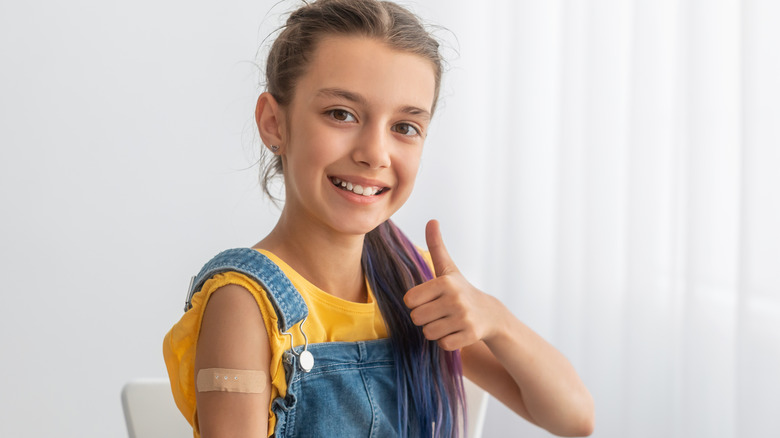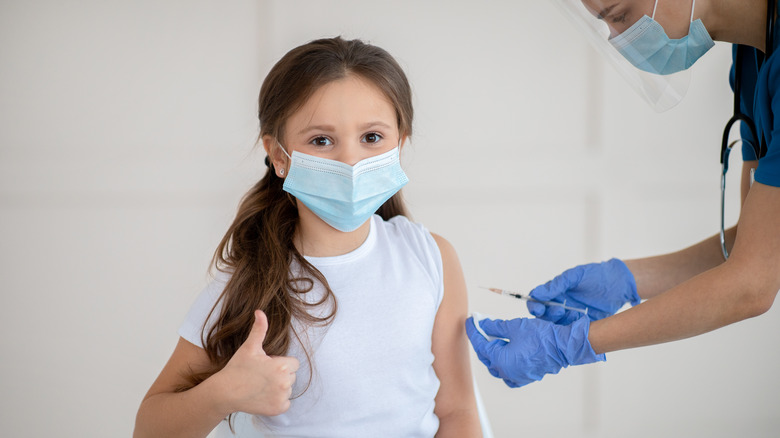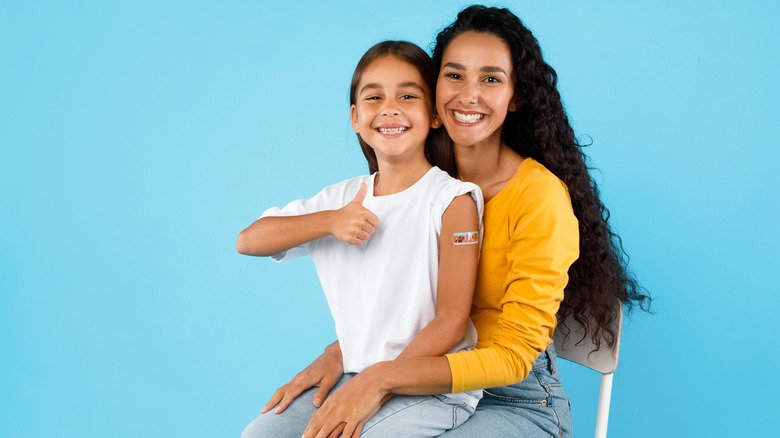What Parents Need To Know About Getting The Bivalent COVID Booster For Their Young Children
Nowadays, it can be hard to imagine a time when COVID wasn't a household term, but such a time did exist. COVID was first discovered in the U.S. in January 2020, and the World Health Organization declared it a pandemic two months later, per the CDC. We've learned a lot about the virus in the months and years since, and one of the accomplishments was the creation of vaccines to help protect against COVID – Dolly Parton even helped out with funding the vaccine.
By late October 2021, COVID vaccines were approved by the CDC for children ages 5 to 11, and by June 2022, they were approved for children ages 6 months to 4 years old, per the U.S. Department of Health and Human Services. This meant pretty much the entire country, barring any contraindications, was eligible to be vaccinated. The latest development is that there's a booster that's been approved for kids. On October 12, the CDC confirmed that the updated bivalent COVID-19 vaccine booster could be used for kids. This ties to the FDA's recommendation, which is dependent upon vaccine type. They've authorized the Moderna vaccine bivalent booster for kids 6 and older, and the Pfizer-BioNTech bivalent booster for kids 5 and older.
It's important to remember to watch out for misinformation about the COVID vaccine and your kids; before making an appointment, here's what you need to know.
The bivalent COVID booster is only for use after the primary series
What's unique about the bivalent booster is that it helps protect against both the original strain of COVID-19 as well as two Omicron Covid mutations that have developed. The subvariants of Omicron being targeted with the vaccines are BA.4 and BA.5, which are the most contagious and anticipated to be the most dominant through the winter, per Yale Medicine. The reason it's referred to as bivalent is that it has two messenger RNA (mRNA) components.
While kids down to the ages of 5 and 6 are eligible for the booster, keep in mind that it is a booster. A primary series of COVID vaccines must be completed before anyone — regardless of age — is eligible for the booster. The recommendation is to wait two months after the last vaccine in the primary series or before the last booster before getting a booster, according to Yale Medicine. Booster shots as well as the primary vaccine series are free, according to AMA. There are potential side effects to the booster that are similar to the primary series, including chills, fatigue, headache, nausea, and fever, per AMA.
The bivalent booster hospitalization reduction rates are unknown
There are some additional considerations for getting the COVID booster for your kids is if they have had COVID recently. If they have, CNN Medical Analyst Dr. Leana Wen told CNN "to wait at least three months" before getting the booster as their bodies will be building natural immunity and they're unlikely to get reinfected during that time.
Wen cautioned that, with the new booster, there still isn't concrete data for "how long the booster will be effective in reducing symptomatic infection." But with the potential for a fall and winter surge of COVID cases, a booster now could help protect against that. As for the impacts of the original vaccine series — the monovalent strains — for kids, Wen noted that it was proven to reduce hospitalizations by more than 80%, though it's not yet clear how the booster has or will help hospitalization rates.
COVID-19 is generally less severe for kids compared to adults, said Peter Marks, M.D., Ph.D., Director of the Center for Biologics Evaluation and Research (CBER) at the Food and Drug Administration (FDA) in a press release from the FDA. But he recommends vaccination for kids considering kids are back to in-person school and "people are resuming pre-pandemic behaviors and activities, [which means] there is the potential for increased risk of exposure to the virus that causes COVID-19."


